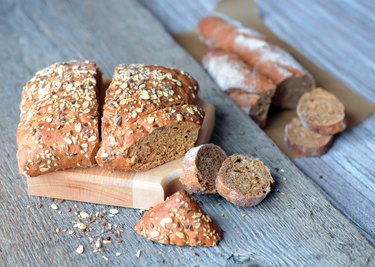
An unfamiliar ingredient to most home bakers, lecithin is widely used in commercial baking. It's an emulsifier, an ingredient that helps other ingredients to mix more easily and remain mixed. Bakeries add lecithin to bread and other baked goods to improve doughs and batters, or to keep them from staling. It's also used in eggless baking, where it can replace the naturally occurring lecithin in egg yolks.
As a Dough Conditioner
Video of the Day
Step 1
Measure 1/2 to 1 teaspoon of lecithin granules for every cup of flour in a recipe.
Video of the Day
Step 2
Dissolve the lecithin in the liquid ingredients.
Step 3
Prepare the baked goods as you normally would and bake them until done.
Step 4
Taste and evaluate the finished goods. If their texture is not yet as improved as you'd like or if they still stale more quickly than you'd like, add more lecithin in the next batch. If the lecithin leaves a detectable flavor in the finished goods, reduce the quantity in your next batch.
In Eggless Baking
Step 1
Dissolve 1 1/2 tablespoons of lecithin granules in 2 teaspoons of water for each egg yolk called for in a recipe.
Step 2
Increase the water to 1 1/2 tablespoons if you're replacing a whole egg, rather than a yolk.
Step 3
Add fat, flavorings, binding ingredients or leaveners as necessary to complement the lecithin and account for the eggs' other roles in your recipe (see Tips).
Tip
If you're using lecithin in cakes, muffins or quickbreads, use the smaller quantity per cup of flour. It will give your goods a softer texture and prolong their shelf life.
For yeast breads that already contain dough-softening ingredients such as milk, sugar or butter, start with the smaller quantity of lecithin. For breads without those enriching ingredients or breads that have a coarse texture from whole-grain flour, start with the larger quantity.
Eggless baking is a complicated process, requiring a great deal of trial and error. Lecithin and other emulsifiers occur naturally in egg yolks, helping bind water-based ingredients such as milk to fat-based ingredients such as butter. Soy lecithin does this admirably, but it doesn't provide the flavor, the fat, or the binding and leavening effects you'd get with eggs.
Many recipes give a better result if you add a teaspoon of fat to provide the richness you'd otherwise get with egg yolks. In cakes, cookies and other baked goods where eggs provide leavening, adding up to 1/2 teaspoon of baking powder can help preserve a lighter texture. Starch thickeners such as cornstarch, or gelling agents such as xanthan gum and guar gum, can help provide the structure and sturdiness that egg whites would otherwise provide.